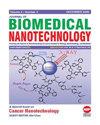Multifunctional Biocompatible Rhinacanthus nasutus Based TiO2-Doped CeO Nanoparticles Synthesis and their Biomedical Evaluations; In-Vitro/In-Vivo Approach
IF 2.9
4区 医学
Q1 Medicine
引用次数: 0
Abstract
The work intended to evaluate the potential wound healing properties of TiO 2 doped CeO nanoparticles with the assistance of Rhinacanthus nasutus . Furthermore, an assessment was conducted on the nanoparticles to determine their antioxidant, cytotoxic, anti-diabetic, and anti-inflammatory inhibitory properties, as well as their toxicity in albino rats. The nanoparticles were synthesized in the green method and subjected to characterization through various methods including UV-visible spectroscopy, SEM for morphological study, FTIR to identify functional groups, XRD, and for elemental analysis EDAX. The morphology of the observed nanoparticles were predominantly spherical, exhibiting an agglomerated structure. The findings indicated that approximately 49% of the nanoparticles exhibited DPPH antioxidant activity, as determined by an IC50 value of 2.8 g/mL. The nanoparticles exhibited cytotoxicity in the brine shrimp lethality assay when administered at a concentration of 50 g/mL. Additionally, they displayed notable inhibitory activity against-amylase, with an IC50 value of 2.981 g/mL. The Ames test yielded negative results, suggesting that the nanoparticles exhibited non-toxic properties. In general, the study substantiated the prospective biological uses of TiO 2 -doped CeO nanoparticles.多功能生物相容性鼻棘tio2掺杂CeO纳米颗粒的合成及其生物医学评价体外/体内的方法
本研究旨在评价在鼻棘的辅助下二氧化钛掺杂CeO纳米颗粒的潜在伤口愈合性能。此外,研究人员还对纳米颗粒进行了评估,以确定其抗氧化、细胞毒性、抗糖尿病和抗炎抑制特性,以及它们对白化大鼠的毒性。采用绿色方法合成纳米颗粒,并通过各种方法进行表征,包括紫外可见光谱,SEM(形态学研究),FTIR(鉴定官能团),XRD (x射线衍射)和EDAX元素分析。所观察到的纳米颗粒形貌以球形为主,呈现出团聚结构。结果表明,约49%的纳米颗粒具有DPPH抗氧化活性,IC50值为2.8 g/mL。当浓度为50 g/mL时,纳米颗粒在盐水虾致死试验中表现出细胞毒性。对-淀粉酶具有明显的抑制活性,IC50值为2.981 g/mL。Ames的测试结果为阴性,表明纳米颗粒具有无毒特性。总的来说,该研究证实了二氧化钛掺杂CeO纳米颗粒的生物学应用前景。
本文章由计算机程序翻译,如有差异,请以英文原文为准。
求助全文
约1分钟内获得全文
求助全文
来源期刊
CiteScore
4.30
自引率
17.20%
发文量
145
审稿时长
2.3 months
期刊介绍:
Information not localized

 求助内容:
求助内容: 应助结果提醒方式:
应助结果提醒方式:


